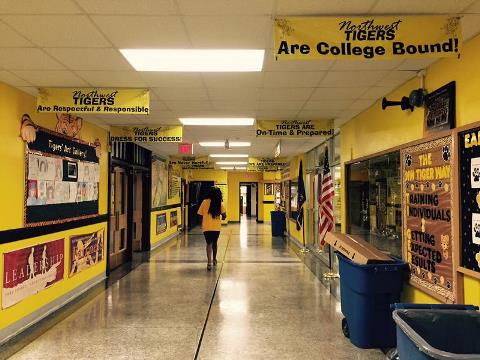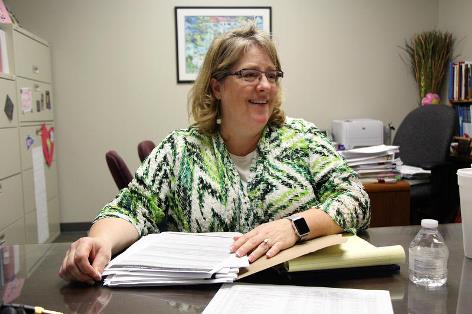
by Celia Llopis-Jepsen, Kansas News Service
On any given school day at Kansas City Kansas Public Schools, students with disabilities receive an array of medical and support services, from physical therapy to help from nurses.
The services are meant to ensure access to education for all children, said Michelle Colvin, director of special education for the district.
“All means all,” Colvin said. “It benefits us to include everyone in our education system.”
Medicaid helps pay for such services — providing around $46 million for schools statewide, according to data from the Kansas Department of Health and Environment.
As Republicans in Congress work on an Obamacare repeal and replacement bill that would impose caps on Medicaid funding and give states more authority to decide who and what to cover, education advocates in Kansas are scrambling to determine how those changes would affect schools.
“We’re trying to get that nailed down,” said Mark Tallman, a lobbyist for the Kansas Association of School Boards, which has been urging its members to contact Sens. Pat Roberts and Jerry Moran with their concerns.
“If federal aid goes down, that doesn’t change the cost to the districts,” he said, referring to federal statute that requires schools to meet the needs of children with disabilities.

(Photo by Celia Llopis-Jepsen, Kansas News Service)
A coalition of concerned groups — ranging from the National Disability Rights Network to the Autistic Self Advocacy Network to the American Psychological Association — are sounding the alarm, warning that proposed caps on federal Medicaid spending risk reducing financial support to schools or even crowding them out of the program.
Such changes “could have devastating effects on our nation’s children,” the groups wrote in an open letter to House and Senate leaders.
In May, the House passed a bill that would curb projected growth in Medicaid spending by $830 billion over the next decade, according to estimates from the nonpartisan Congressional Budget Office. The Senate may soon vote on a version that slashes $770 billion.
Kansas’ four House members voted for their chamber’s version. In the Senate, Moran has said he opposes the bill in its current form and Roberts has voiced support.
Kansas GOP Congressman Kevin Yoder said in a recent emailed statement that the House bill prioritizes Medicaid spending on the elderly and people with disabilities. He noted that the bill cuts growth in spending, rather than reducing current funding levels.
“The bottom line is we are protecting these children by prioritizing them in our reforms and ensuring the Medicaid program will not go insolvent,” Yoder said.
The CBO estimates the House version would cut the federal deficit by about $120 billion over a decade. It pegged the figure at about $320 billion for the Senate version.
Those savings would be achieved in large part by the Medicaid spending caps, which would reduce enrollment by an estimated 14 million to 15 million people by 2026.
Funding caps in the Senate version wouldn’t apply to disabled children, according to the CBO, but educators remain concerned that states could still reduce the funding that schools receive to provide services to students with disabilities.
Areas of impact
Among schools, the state’s biggest Medicaid billers are its largest urban-core districts, which serve high numbers of children from low-income families. These include the 50,000-student Wichita district, the 22,000-student Kansas City, Kansas, district and the 14,000-student Topeka district.
Kansas City, Kansas, schools received about $4.1 million through Medicaid last year. That figure includes money for some services provided to the neighboring Bonner Springs and Piper school districts.
Medicaid in Kansas schools: The top four recipients in 2016 were Wichita Public Schools ($8.14 million), Kansas City, Kansas, Public Schools and two neighboring districts ($4.1 million), Topeka ($2.46 million) and Olathe ($2.14 million).
But smaller districts are worried, too. The National Rural Education Association, part of the coalition concerned about the fate of Medicaid in schools, said losses can be difficult for such districts to absorb.
“Most rural districts are already strapped for cash anyway,” said Allen Pratt, the Tennessee-based group’s executive director. “It’s only going to make things a lot worse.”
There’s some indication Medicaid plays a larger role in increasing access to health care for residents of rural areas and small towns. Research published this month by Georgetown University and the University of North Carolina found that more children in those areas are insured by Medicaid than children living in metropolitan areas.
In Kansas, 36 percent of children in towns and rural areas have Medicaid coverage, compared to 27 percent in metropolitan areas. The rate of uninsured children — about 5 percent — is the same for both.
Erosion of state aid
The decades-old federal law on the educational rights of children with disabilities was born of civil rights efforts that moved schools away from systematically isolating kids with special needs from regular classrooms and other classmates.
It pushes schools to tailor medical and educational services so that children can learn in general education environments as much as possible.
For Colvin, the reasoning is simple: All children should have the opportunity to achieve their potential.
“We have to provide these students with the best possible education,” she said.
But state and federal funding that schools receive doesn’t fully cover the cost of providing the mandated services. And this feeds into school administrators’ fears of losing Medicaid dollars.
Under Kansas law, schools should receive from the state 92 percent of the extra costs associated with educating children with special needs, after adjusting for some federal assistance. But Kansas has ignored that law since 2011. Amid tight budgets in recent years, the state has covered around 80 percent instead.
A key type of federal special education aid is a similar story. According to the National School Boards Association, on a per-student basis, Congress is putting in less than half of what it committed upon passing a landmark special education-related law in 1975.
Kansas lawmakers agreed to add about $12 million to special education funding for next school year — part of their response to the long-running Gannon v. Kansas lawsuit that accuses the state of underfunding public schools. This could lead to a bump in aid per student, but the Kansas Association of School Boards said reductions in Medicaid could easily undo it.
Shifting dollars
The national Save Medicaid in Schools Coalition warns scaling back the program could lead schools to divert money from other education programs to make up the difference. It could also weaken medical and mental health services, the groups said.
Colvin said services for disabled students, whose rights are governed by federal mandates, wouldn’t decrease at her district if Medicaid reimbursements drop in Kansas.
“There’s no negotiation there,” she said, but added that the district would need to pull money from elsewhere in its general budget.
Kansas City, Kansas, Public Schools is one of the plaintiffs in the Gannon lawsuit and has long argued its classrooms are already underfunded.
Colvin also warned that early childhood services billable in part to Medicaid aren’t subject to the same federal mandates, making them more vulnerable.
Kansas City, Kansas, schools serve nearly 700 infants and toddlers born with disabilities or facing other risk factors. About $275,000 for this program comes from Medicaid, and the district would struggle to find the money elsewhere, she said.
“That’s probably more scary to me,” she said. “They don’t have a fallback.”
Celia Llopis-Jepsen is a reporter for the Kansas News Service, a collaboration of KCUR, Kansas Public Radio and KMUW covering health, education and politics. You can reach her on Twitter @Celia_LJ. Kansas News Service stories and photos may be republished at no cost with proper attribution and a link back to kcur.org.
See more at http://kcur.org/post/health-bill-could-reduce-medicaid-services-children-disabilities-kansas-schools.
